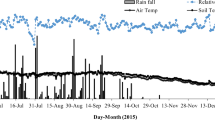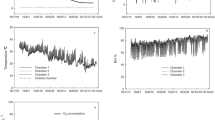Abstract
The main objective of the work described in this paper was to investigate the usefulness of a point-placement technique for investigating nitrogen-use by irrigated rice in a tropical lowland environment. The technique was used to deliver a small quantity of urea 15N to a specific location adjacent to the roots of a rice plant in a few minutes. The amount of 15N delivered was equivalent to 4–8 h of the daily nitrogen uptake requirement of a rice plant. The 15N was placed in a gelatin capsule attached to a wooden handle and the capsule was inserted adjacent to the roots at the soil water interface or at 5 cm soil depth beneath the rice plant. The gelatin dissolves in a few minutes. The plants were harvested at varying intervals through to crop maturity and their 15N content measured. The uptake of 15N followed an exponential pattern and it took approximately two weeks to reach a maximum of about 65% of the initial quantity supplied. The time to reach maximum uptake was unexpectedly slow and a simple theory was developed to better understand the processes governing the uptake and loss of the 15N. There were no differences between the applications made at the soil surface and those made 5 cm below the surface. The technique worked very well for tracking the fate of nitrogen acquired by the plant at different growth stages. For example, 14 days after label application at 10 days after transplanting (DAT), 66% of the labeled N acquired by the plant was found in the leaves, 26% in the stems and sheaths, and 8% in the roots. About 37% of the label supplied on 10 DAT was located in the grain at maturity suggesting the technique can be used to follow the nitrogen dynamics of irrigated rice crops.
Similar content being viewed by others
References
Cassman K G and Samson M I 1994 Nitrogen supply or root function: What governs N uptake in irrigated rice? In SARP Research Proceedings. Nitrogen economy of irrigated rice: field and simulation studies. Eds. H F M Ten Berge, M C S Wopereis and J C Shin, pp. 302–303. Grafisch Service Centrum Van Gils B.V., Wageningen.
Cassman K G and Pingali P L 1995 Extrapolating trends from longterm experiments to farmer's fields: The case of irrigated rice systems in Asia. In Agricultural Sustainability: Economic Environment and Statistical Considerations. Eds. V Varnett, R Payne and R Steiner, pp. 63–84. John Wiley & Sons Ltd., London, U.K.
Cassman K G, Dizon M A, Samson M I and Alcantara J M 1996 Nitrogen use efficiency in tropical lowland rice systems: Contributions from indigenous and applied nitrogen. Field Crops Res. 47, 1–12.
Cassman K G, Kropff M J, Gaunt J and Peng S 1993 Nitrogen use efficiency of rice reconsidered: What are the key constraints? Plant Soil 155/156, 359–362.
Craswell E T and Vlek P L G 1979 Fate of fertilizer nitrogen applied to wetland rice. pp. 174–192. In Nitrogen and Rice. International Rice Research Institute Los Baños, Philippines.
De Datta S K and Buresh R J 1989 Integrated nitrogen management in irrigated rice. Adv. Agron. 10, 143–169.
De Datta S K, Gomez K A and Descalsota J 1988 Changes in yield response to major nutrients and in soil fertility under intensive rice cropping. Soil Sci. 146, 350–358.
Evans D 2001 Physiological mechanisms influencing plant nitrogen isotope composition. Trends Plant Sci. 6, 121–126.
Fillery I R P and Vlek P L G 1986 Reappraisal of the significance of ammonia volatilization as an N loss mechanism in flooded rice fields. Fert. Res. 9, 188–194.
Freney J R, Trevitt A C F, Muirhead W A, Denmead O T, Simpson J R and Obcemea W N 1988 Effect of water depth on ammonia loss for lowland rice. Fert. Res. 16, 97–107.
Friedrich J W and Schrader L E 1979 Nitrogen deprivation in maize during grain filling. II. Remobilization of 15N and 35S and the relationship between N and S accumulation. Agron. J. 71, 466–472.
Mae T and Okira K 1981 The remobilization of nitrogen related to leaf growth and senescence in rice plants (Oryza sativa L.). Plant Cell Physiol. 22, 1067–1074.
Mishra B and Kirk G J D 1994 A mechanistic model of N dynamics in flooded soil. In SARP Research Proceedings. Nitrogen economy of irrigated rice: Field and simulation studies. 1–10 Nov. 1993. Eds. H F M ten Berge, M C S Woperies and J C Shin, pp. 293–301. Grafisch Service Centrum Van Gils B.V., Wageningen.
Mood A M, Graybill F A and Boes D C 1974 Introduction to theory of statistics. 3rd Ed. Mc Graw-Hill Inc, 564 pp.
Nye P H and Tinker P B 1977 Solute movement in the soil-root system. Blackwell Scientific, Oxford.
Peng S and Cassman K G 1998 Upper thresholds of nitrogen uptake rates and associated nitrogen fertilizer efficiencies in irrigated rice. Agron. J. 90, 178–185.
Peng S, Garcia F V, Laza R C, Sanico A L, Samson M I, Visperas R M and Cassman K G 1996 Nitrogen use efficiency of irrigated tropical rice established by broadcast wet seeding and transplanting. Fert. Res. 45, 123–134.
Rachhpal-Singh and Kirk G J D 1993a A model for predicting the fate of nitrogen fertilizer in lowland rice fields. Theory. J. Soil Sci. 44, 271–283.
Rachhpal-Singh and Kirk G J D 1993b A model for predicting the fate of nitrogen fertilizer in lowland rice fields. 11. Predicted dynamics of inorganic carbon nitrogen and acidity in the soil and floodwater. J. Soil Sci. 44, 285–297.
Sheehy J E, Dionora M J A, Mitchell P L, Peng S, Cassman K G, Lemaire G and Williams R L 1998 Critical nitrogen concentrations: implications for high yielding rice (Oryza sativa L.) cultivars in the tropics. Field Crops Res. 59, 31–41.
Singh U, Cassman K G, Ladha J K and Bronson K F 1995 Innovative nitrogen management strategies for low land rice systems. In Fragile lives in fragile ecosystems, pp. 229–254. IRRI, P.O. Box 933, Manila Philippines.
Vlek P L G and Byrnes B H 1986 The efficacy and loss of fertilizer N in lowland rice. Fert. Res. 9, 131–147.
Witt C, Dobermann A, Abdulrachman S, Gines H C, Guanghuo W, Nagarajan R, Satawatananont S, Son T T, Tan P S, Tiem L, Simbahan G C and Olk D C 1999 Internal nutrient efficiencies of irrigated lowland rice in tropical and subtropical Asia. Field Crops Res. 63, 113–138.
Author information
Authors and Affiliations
Rights and permissions
About this article
Cite this article
Sheehy, J., Mnzava, M., Cassman, K. et al. Uptake of nitrogen by rice studied with a 15N point-placement technique. Plant and Soil 259, 259–265 (2004). https://doi.org/10.1023/B:PLSO.0000020968.84809.38
Issue Date:
DOI: https://doi.org/10.1023/B:PLSO.0000020968.84809.38




